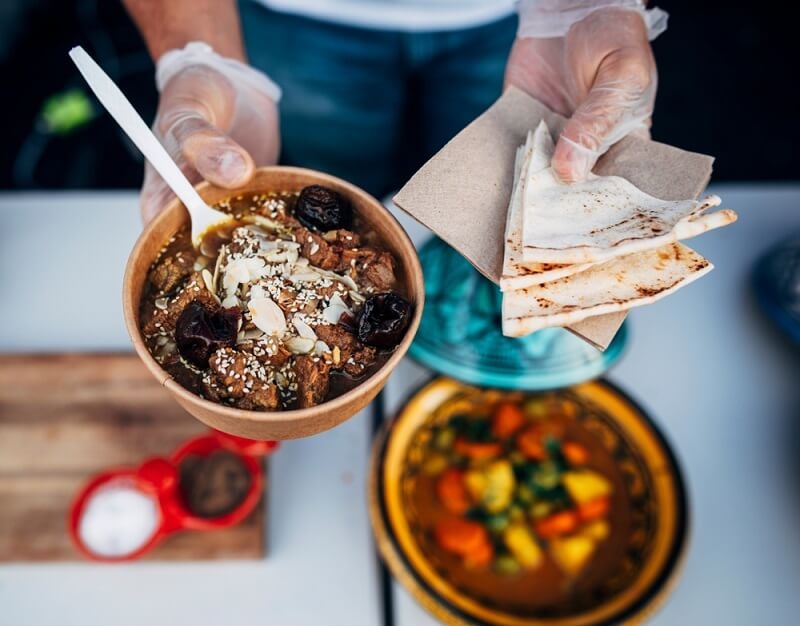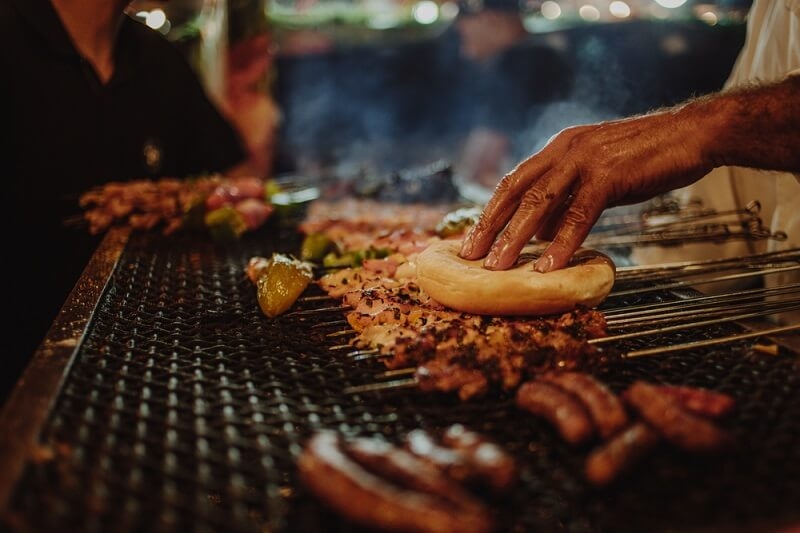
There’s a kind of magic that happens when you wander down an Algerian street around sunset. The air hums with chatter. Oil crackles in big, shallow pans. The smell of cumin, chili, and fresh bread wraps around you before you even see what’s cooking. You don’t just eat Algerian street food—you live it.
Street food here isn’t about fine dining or polished plates. It’s about community. It’s about flavor that hits before thought. It’s old recipes, often passed down quietly in families, made on carts and corners with a kind of effortless pride. The taste? It’s the heartbeat of daily Algeria.
If you’ve ever been to Algiers, Oran, or Constantine, you know that the streets don’t just move—they breathe. And food is how they breathe best. Vendors line narrow lanes with trays of fried dough, steaming chickpeas, and grilled flatbreads that somehow make you hungrier the longer you walk.
You’ll see office workers eating with one hand, school kids sharing from a single paper wrap, old men sipping mint tea next to skewers sizzling over coals. Food here isn’t separate from life. It’s woven into it.
Algerian street food is shaped by a mix of Mediterranean freshness, Berber tradition, and Arab spice. You taste olive oil, tomato, semolina, garlic, and that unmistakable touch of cumin in nearly every dish.
And the best part? It’s messy. Imperfect. Exactly how it should be.
If you try just one thing, make it Mahjouba. It’s Algeria’s answer to the perfect handheld comfort food. Somewhere between a crepe and a stuffed pancake, Mahjouba is made with semolina dough, thinly rolled, filled with a rich tomato and onion mixture, and cooked on a flat griddle until golden and slightly crisp.
The filling isn’t complicated—just onions sautéed until sweet, tomatoes cooked down with chili and paprika, maybe a bit of harissa if the vendor likes heat. But when it’s all wrapped up inside that thin layer of dough, it’s perfect.
You’ll find Mahjouba in almost every city, sold from tiny carts, by women who’ve perfected their technique over years. Some cut them into squares, others fold them like envelopes. Either way, they’re eaten hot, sometimes with a spoonful of harissa on top or a squeeze of lemon.
It’s not fancy. It doesn’t need to be. One bite, and you’ll understand why locals call it the queen of Algerian street food.

If Mahjouba is the queen, kesra Algeria is the soul. It’s the bread that shows up everywhere—at breakfast, lunch, and dinner—but the street version has its own rustic charm.
Kesra is made from semolina, water, a little oil, and salt. That’s it. No yeast. No fuss. It’s kneaded by hand and cooked on a flat griddle, called a “tajine,” until the surface blisters slightly and the inside stays soft. Vendors often sell it with honey, olive oil, or spicy dips made from tomato and chili.
There’s something hypnotic about watching a woman shape kesra with her palms, dusting it with flour, turning it just so on the hot metal plate. The smell is warm, nutty, almost buttery even though there’s no butter in sight.
It’s simple food that does what food should do—it fills you up and makes you happy. And when you tear a piece and eat it warm with a dab of chili paste, you realize that kesra Algeria isn’t just bread. It’s comfort, plain and pure.
Wander through any city market and you’ll notice that Algerian food stalls are rarely quiet. There’s motion everywhere—men flipping flatbreads, women arranging trays of sweet pastries, kids carrying small paper cones of roasted chickpeas or peanuts.
These stalls are a world of flavor in miniature. They sell everything from spicy merguez sausages to stuffed baguettes overflowing with fries, pickles, and eggs. Yes, Algerians love their sandwiches with fries inside. No one’s complaining.
In coastal towns like Algiers or Bejaia, seafood also takes center stage. Fresh sardines, deep-fried in spiced flour, are served in baguettes with harissa and lemon. The taste is sharp and satisfying, like the sea itself.
And in mountain towns, you might find hearty lentil soup or chickpea stew bubbling in big pots. People stop, chat, eat, and move on. No rush. No rules.
That’s what makes Algerian food stalls so special. Every one of them tells a story—of family, of tradition, of survival through flavor.
Street food in Algeria isn’t only about meals. It’s also about Algerian snacks—the in-between bites that keep life moving. You’ll find roasted chickpeas sold in paper cones, spicy potato fritters called “maâkouda,” and small pastries dripping with honey and sesame.
On cool evenings, vendors serve bowls of “chakhchoukha,” torn pieces of flatbread soaked in spiced tomato sauce, topped with chickpeas or lentils. It’s warm, filling, and smells like home.
Then there’s “kalb el louz,” literally “heart of almonds,” a dense almond and semolina cake soaked in syrup, cut into perfect diamonds. Sweet, sticky, and impossible to stop eating.
And for the simplest kind of joy? Grab a paper cup of “hamoud boualem,” Algeria’s famous lemon soda, ice-cold and fizzy. It’s been around since 1878, and nothing beats it with hot fries or a spicy wrap.
Algerian snacks are proof that great flavor doesn’t need a table or a reservation. Just hands, appetite, and curiosity.
You can’t talk about street food favorites in Algeria without mentioning the holy trio: karantika, rechta, and lablebi.
Karantika is perhaps the most beloved of all. It’s made from chickpea flour, water, and oil, baked until golden and soft inside. Eaten hot with cumin and harissa, usually in a baguette, it’s a humble masterpiece. People line up for it before noon. The texture is soft, like a cross between custard and pancake, and every bite feels like comfort.
Rechta is a noodle dish, usually served during special occasions but also found at stalls during festivals. The noodles are handmade, steamed, then mixed with chickpeas, turnips, and a light spiced broth. It’s delicate, full of flavor, and smells of cinnamon and onion.
Lablebi, originally from Tunisia but loved across Algeria, is chickpeas in a spicy broth topped with bread, eggs, and sometimes sausage. Cheap, filling, and packed with flavor—it’s a meal that warms more than your stomach.
Together, these street food favorites show how Algerians make ordinary ingredients extraordinary.
If you’ve still got room (and trust me, you’ll want to make some), the sweets will pull you in. Trays of baklava glisten with honey. Round makroud pastries filled with dates sit stacked like golden bricks. Vendors drizzle syrup until it pools at the bottom of the tray, then sprinkle everything with sesame seeds.
Sugar is serious business here. It’s not just dessert—it’s a ritual. Sweet things are always served with mint tea, poured from a height so the foam rises in the glass. The tea is strong and fragrant, cutting through the richness of honey and almonds.
There’s something beautifully old-fashioned about standing by a stall, sipping hot tea, biting into sticky pastry, and watching the world pass. It’s slow food, even when eaten fast.
Part of what makes Algerian street food so special is how it bridges cultures. It’s not one flavor—it’s many. Berber roots mix with Arab, Ottoman, and French influences. A baguette might hold merguez sausage and harissa. A crepe might hide tuna and olives. A pastry might mix almonds with orange blossom water and semolina.
It’s fusion, but not the kind cooked up for trends. It’s fusion born from history, from trade routes, from people who’ve shared meals across centuries.
And somehow, it all works. It’s spicy but not overwhelming. Rich but balanced. Every bite feels like a conversation between past and present.
If you ever find yourself on a bustling Algerian street, skip the restaurants for a day. Follow your nose. Look for the stalls with the biggest crowds. That’s your sign.
Start light: maybe a small Mahjouba, steaming and golden, with a dollop of chili paste. Then grab a cup of mint tea. When you’re ready for more, find a kesra Algeria stall and try it warm with honey or olive oil.
End your journey with something sweet. Makroud or baklava. Don’t rush it. Sit if you can. Talk to the vendor. They’ll probably smile and tell you how long they’ve been making it. And then they’ll hand you a second piece, “just to taste.”
That’s the beauty of it—street food here is personal. It’s generous.
At night, when the sky darkens and the calls of vendors start to fade, the smell of grilled bread and spices still lingers in the air. You can walk down almost any Algerian street and still catch a trace of cumin, a whisper of frying oil. It stays with you, long after you’ve eaten.
Because Algerian street food isn’t just about filling hunger—it’s about belonging. It’s food that reminds people who they are, and for travelers, it’s food that opens doors to understanding.
So, next time you’re in Algiers or Oran, skip the menu and follow the smoke, the sound, the laughter. Your best meal might be waiting on a cart at the corner, wrapped in paper, still warm from the griddle.
And when you take that first bite, messy and hot and absolutely perfect, you’ll know what every local already knows: the streets of Algeria taste like home.
This content was created by AI